Microwave Vegetation Index from Multi-Angular Observations and Its Application in Vegetation Properties Retrieval: Theoretical Modelling
Abstract
1. Introduction
2. Data and Methodologies
2.1. Data
2.2. Radiative Transfer Model (Tor Vergata Model)
2.3. Multi-Angular Microwave Vegetation Index (MVI)
2.3.1. Derivation of Multi-Angular MVI
2.4. Optical Depth
2.4.1. Optical Depth Simulation
2.4.2. Optical Depth and Vegetation Water Content (VWC) retrieval from MVI
3. Results
3.1. The Validity of the Tor Vergata Model and MVI Technique
3.2. Multi-Angular MVI for Corn and Wheat
3.3. Application for Vegetation Optical Depth (VOD) and VWC Retrieval
4. Discussion
4.1. Assumptions
4.2. Sensitivity of MVI to Vegetation Properties
5. Conclusions
Author Contributions
Funding
Acknowledgments
Conflicts of Interest
References
- Huete, A.R. A soil-adjusted vegetation index (SAVI). Remote Sens. Environ. 1988, 25, 295–309. [Google Scholar] [CrossRef]
- Myneni, R.; Ganapol, B.; Asrar, G. Remote sensing of vegetation canopy photosynthetic and stomatal conductance efficiencies. Remote Sens. Environ. 1992, 42, 217–238. [Google Scholar] [CrossRef]
- Myneni, R.B.; Hall, F.G.; Sellers, P.J.; Marshak, A.L. The interpretation of spectral vegetation indexes. IEEE Trans. Geosci. Remote Sens. 1995, 33, 481–486. [Google Scholar] [CrossRef]
- Tucker, C.J. Red and photographic infrared linear combinations for monitoring vegetation. Remote Sens. Environ. 1979, 8, 127–150. [Google Scholar] [CrossRef]
- Shi, J.; Jackson, T.; Tao, J.; Du, J.; Bindlish, R.; Lu, L.; Chen, K. Microwave vegetation indices for short vegetation covers from satellite passive microwave sensor AMSR-E. Remote Sens. Environ. 2008, 112, 4285–4300. [Google Scholar] [CrossRef]
- Chen, P.-Y.; Fedosejevs, G.; Tiscareno-Lopez, M.; Arnold, J.G. Assessment of MODIS-EVI, MODIS-NDVI and VEGETATION-NDVI composite data using agricultural measurements: An example at corn fields in western Mexico. Environ. Monit. Assess. 2006, 119, 69–82. [Google Scholar] [CrossRef] [PubMed]
- Asner, G.P.; Scurlock, J.M.; A Hicke, J. Global synthesis of leaf area index observations: Implications for ecological and remote sensing studies. Glob. Ecol. Biogeogr. 2003, 12, 191–205. [Google Scholar] [CrossRef]
- Alemu, W.G.; Henebry, G.M. Comparing passive microwave with visible-to-near-infrared phenometrics in croplands of northern Eurasia. Remote Sens. 2017, 9, 613. [Google Scholar] [CrossRef]
- Njoku, E.G.; Li, L. Retrieval of land surface parameters using passive microwave measurements at 6-18 GHz. IEEE Trans. Geosci. Remote Sens. 1999, 37, 79–93. [Google Scholar] [CrossRef]
- Chai, L.; Shi, J.; Zhang, L.; Jackson, T. Refinement of microwave vegetation indices. In Remote Sensing and Modeling of Ecosystems for Sustainability VII; International Society for Optics and Photonics: San Diego, CA, USA, 2010; p. 780904. [Google Scholar]
- Njoku, E.G.; Chan, S.K. Vegetation and surface roughness effects on AMSR-E land observations. Remote Sens. Environ. 2006, 100, 190–199. [Google Scholar] [CrossRef]
- Becker, F.; Choudhury, B.J. Relative sensitivity of normalized difference vegetation index (NDVI) and microwave polarization difference index (MPDI) for vegetation and desertification monitoring. Remote Sens. Environ. 1988, 24, 297–311. [Google Scholar] [CrossRef]
- Zhao, T.; Zhang, L.; Shi, J.; Jiang, L. A physically based statistical methodology for surface soil moisture retrieval in the Tibet Plateau using microwave vegetation indices. J. Geophys. Res. Atmosp. 2011, 116. [Google Scholar] [CrossRef]
- Kerr, Y.H.; Njoku, E.G. A semiempirical model for interpreting microwave emission from semiarid land surfaces as seen from space. IEEE Trans. Geosci. Remote Sens. 1990, 28, 384–393. [Google Scholar] [CrossRef]
- Kurum, M. Quantifying scattering albedo in microwave emission of vegetated terrain. Remote Sens. Environ. 2013, 129, 66–74. [Google Scholar] [CrossRef]
- Chaparro, D.; Piles, M.; Vall-llossera, M.; Camps, A.; Konings, A.G.; Entekhabi, D. L-band vegetation optical depth seasonal metrics for crop yield assessment. Remote Sens. Environ. 2018, 212, 249–259. [Google Scholar] [CrossRef]
- Ulaby, F.T.; Moore, R.K.; Fung, A.K. Microwave Remote Sensing Active and Passive-Volume III: From theory to Applications; Mart Press, Inc.: North Bergen, NJ, USA, 1986. [Google Scholar]
- Jackson, T.; Schmugge, T. Vegetation effects on the microwave emission of soils. Remote Sens. Environ. 1991, 36, 203–212. [Google Scholar] [CrossRef]
- Cui, Q.; Shi, J.; Du, J.; Zhao, T.; Xiong, C. An Approach for Monitoring Global Vegetation Based on Multiangular Observations From SMOS. IEEE J. Sel. Top. Appl. Earth Obs. Remote Sens. 2015, 8, 604–616. [Google Scholar] [CrossRef]
- Vittucci, C.; Ferrazzoli, P.; Kerr, Y.; Richaume, P.; Guerriero, L.; Rahmoune, R.; Laurin, G.V. SMOS retrieval over forests: Exploitation of optical depth and tests of soil moisture estimates. Remote Sens. Environ. 2016, 180, 115–127. [Google Scholar] [CrossRef]
- Konings, A.G.; Piles, M.; Rötzer, K.; McColl, K.A.; Chan, S.K.; Entekhabi, D. Vegetation optical depth and scattering albedo retrieval using time series of dual-polarized L-band radiometer observations. Remote Sens. Environ. 2016, 172, 178–189. [Google Scholar] [CrossRef]
- Fan, L.; Wigneron, J.-P.; Xiao, Q.; Al-Yaari, A.; Wen, J.; Martin-StPaul, N.; Dupuy, J.-L.; Pimont, F.; Al Bitar, A.; Fernandez-Moran, R. Evaluation of microwave remote sensing for monitoring live fuel moisture content in the Mediterranean region. Remote Sens. Environ. 2018, 205, 210–223. [Google Scholar] [CrossRef]
- Grant, J.; Wigneron, J.-P.; De Jeu, R.; Lawrence, H.; Mialon, A.; Richaume, P.; Al Bitar, A.; Drusch, M.; Van Marle, M.; Kerr, Y. Comparison of SMOS and AMSR-E vegetation optical depth to four MODIS-based vegetation indices. Remote Sens. Environ. 2016, 172, 87–100. [Google Scholar] [CrossRef]
- Hornbuckle, B.K.; Patton, J.C.; VanLoocke, A.; Suyker, A.E.; Roby, M.C.; Walker, V.A.; Iyer, E.R.; Herzmann, D.E.; Endacott, E.A. SMOS optical thickness changes in response to the growth and development of crops, crop management, and weather. Remote Sens. Environ. 2016, 180, 320–333. [Google Scholar] [CrossRef]
- Patton, J.; Hornbuckle, B. Initial validation of SMOS vegetation optical thickness in Iowa. IEEE Geosci. Remote Sens. Lett. 2013, 10, 647–651. [Google Scholar] [CrossRef]
- Brandt, M.; Rasmussen, K.; Peñuelas, J.; Tian, F.; Schurgers, G.; Verger, A.; Mertz, O.; Palmer, J.R.; Fensholt, R. Human population growth offsets climate-driven increase in woody vegetation in sub-Saharan Africa. Nat. Ecol. Evol. 2017, 1, 0081. [Google Scholar] [CrossRef] [PubMed]
- Wigneron, J.-P.; Jackson, T.; O’Neill, P.; De Lannoy, G.; De Rosnay, P.; Walker, J.; Ferrazzoli, P.; Mironov, V.; Bircher, S.; Grant, J. Modelling the passive microwave signature from land surfaces: A review of recent results and application to the L-band SMOS & SMAP soil moisture retrieval algorithms. Remote Sens. Environ. 2017, 192, 238–262. [Google Scholar]
- Ulaby, F.; Moore, R.; Fung, A. Microwave Remote Sensing: Active, Passive vol III: From Theory to Applications; Artech House: Dedham, MA, USA, 1986; Chapter 13, Part 6(13-6); pp. 1146–1147. [Google Scholar]
- Ferrazzoli, P.; Wigneron, J.-P.; Guerriero, L.; Chanzy, A. Multifrequency emission of wheat: Modeling and applications. IEEE Trans. Geosci. Remote Sens. 2000, 38, 2598–2607. [Google Scholar]
- Della Vecchia, A.; Ferrazzoli, P.; Guerriero, L.; Blaes, X.; Defourny, P.; Dente, L.; Mattia, F.; Satalino, G.; Strozzi, T.; Wegmuller, U. Influence of geometrical factors on crop backscattering at C-band. IEEE Trans. Geosci. Remote Sens. 2006, 44, 778–790. [Google Scholar] [CrossRef]
- Ferrazzoli, P.; Guerriero, L. Passive microwave remote sensing of forests: A model investigation. IEEE Trans. Geosci. Remote Sens. 1996, 34, 433–443. [Google Scholar] [CrossRef]
- Karam, M.A.; Fung, A.K.; Antar, Y.M. Electromagnetic wave scattering from some vegetation samples. IEEE Trans. Geosci. Remote Sens. 1988, 26, 799–808. [Google Scholar] [CrossRef]
- LeVine, D.; Meneghini, R.; Lang, R.; Seker, S. Scattering from arbitrarily oriented dielectric disks in the physical optics regime. JOSA 1983, 73, 1255–1262. [Google Scholar] [CrossRef]
- Bracaglia, M.; Ferrazzoli, P.; Guerriero, L. A fully polarimetric multiple scattering model for crops. Remote Sens. Environ. 1995, 54, 170–179. [Google Scholar] [CrossRef]
- Chen, K.-S.; Wu, T.-D.; Tsang, L.; Li, Q.; Shi, J.; Fung, A.K. Emission of rough surfaces calculated by the integral equation method with comparison to three-dimensional moment method simulations. IEEE Trans. Geosci. Remote Sens. 2003, 41, 90–101. [Google Scholar] [CrossRef]
- Paloscia, S.; Macelloni, G.; Santi, E. Soil moisture estimates from AMSR-E brightness temperatures by using a dual-frequency algorithm. IEEE Trans. Geosci. Remote Sens. 2006, 44, 3135–3144. [Google Scholar] [CrossRef]
- Van de Griend, A.A.; Wigneron, J.-P. The b-factor as a function of frequency and canopy type at H-polarization. IEEE Trans. Geosci. Remote Sens. 2004, 42, 786–794. [Google Scholar] [CrossRef]
- Li, Y.; Shi, J.; Liu, Q.; Dou, Y.; Zhang, T. The development of microwave vegetation indices from WindSat data. IEEE J. Sel. Top. Appl. Earth Obs. Remote Sens. 2015, 8, 4379–4395. [Google Scholar] [CrossRef]
- De Jeu, R.A.; Holmes, T.R.; Van der Werf, G. Towards the development of a 30 year record of remotely sensed vegetation optical depth. In Proceedings of SPIE Europe Remote Sensing; International Society for Optics and Photonics: Berlin, Germany, 2009. [Google Scholar]
- Ulaby, F.T.; Moore, R.K.; Fung, A.K. Microwave Remote Sensing: Active and Passive. Vol. 2, Radar Remote Sensing and Surface Scattering and Emission Theory; Addison-Wesley: Reading, MA, USA, 1982. [Google Scholar]
- Tsang, L.; Kong, J.A.; Shin, R.T. Theory of Microwave Remote Sensing; Massachusetts Inst. of Tech: Cambridge, MA, USA, 1985. [Google Scholar]
- Kurum, M.; Lang, R.H.; O’Neill, P.E.; Joseph, A.T.; Jackson, T.J.; Cosh, M.H. A first-order radiative transfer model for microwave radiometry of forest canopies at L-band. IEEE Trans. Geosci. Remote Sens. 2011, 49, 3167–3179. [Google Scholar] [CrossRef]
- O’Neill, P.; Chan, S.; Njoku, E.; Jackson, T.; Bindlish, R. Soil Moisture Active Passive (SMAP) Algorithm Theoretical Basis Document (ATBD). SMAP Level 2 & 3 Soil Moisture (Passive),(L2_SM_P, L3_SM_P). Initial Release, 1. 2012. Available online: https://smap.jpl.nasa.gov/files/smap2/L2&3_SM_P_InitRel_v1_filt2.pdf (accessed on 25 March 2019).
- Ferrazzoli, P.; Guerriero, L.; Paloscia, S.; Pampaloni, P. Modeling X and Ka band emission from leafy vegetation. J. Electromagn. Waves Appl. 1995, 9, 393–406. [Google Scholar]
- Ferrazzoli, P.; Guerriero, L.; Wigneron, J.-P. Simulating L-band emission of forests in view of future satellite applications. IEEE Trans. Geosci. Remote Sens. 2002, 40, 2700–2708. [Google Scholar] [CrossRef]
- Eom, H.; Fung, A. A scatter model for vegetation up to Ku-band. Remote Sens. Environ. 1984, 15, 185–200. [Google Scholar] [CrossRef]
- Peischl, S.; Walker, J.P.; Ye, N.; Ryu, D.; Kerr, Y. Sensitivity of multi-parameter soil moisture retrievals to incidence angle configuration. Remote Sens. Environ. 2014, 143, 64–72. [Google Scholar] [CrossRef]
- Ulaby, F.T.; Wilson, E.A. Microwave attenuation properties of vegetation canopies. IEEE Trans. Geosci. Remote Sens. 1985, 746–753. [Google Scholar] [CrossRef]
- Ulaby, F.T.; El-Rayes, M.A. Microwave dielectric spectrum of vegetation-Part II: Dual-dispersion model. IEEE Trans. Geosci. Remote Sens. 1987, 550–557. [Google Scholar] [CrossRef]
- Ulaby, F.T.; Kouyate, F.; Brisco, B.; Williams, T.L. Textural infornation in SAR images. IEEE Trans. Geosci. Remote Sens. 1986, 235–245. [Google Scholar] [CrossRef]
- Seo, D.; Lakhankar, T.; Khanbilvardi, R. Sensitivity analysis of b-factor in microwave emission model for soil moisture retrieval: A case study for SMAP mission. Remote Sens. 2010, 2, 1273–1286. [Google Scholar] [CrossRef]
- Hunt, E.R.; Li, L.; Friedman, J.M.; Gaiser, P.W.; Twarog, E.; Cosh, M.H. Incorporation of Stem Water Content into Vegetation Optical Depth for Crops and Woodlands. Remote Sens. 2018, 10, 273. [Google Scholar] [CrossRef]
- Santi, E.; Paloscia, S.; Pettinato, S.; Fontanelli, G.; Mura, M.; Zolli, C.; Maselli, F.; Chiesi, M.; Bottai, L.; Chirici, G. The potential of multifrequency SAR images for estimating forest biomass in Mediterranean areas. Remote Sens. Environ. 2017, 200, 63–73. [Google Scholar] [CrossRef]
- Allen, C.; Ulaby, F. Modelling the polarization dependence of the attenuation in vegetation canopies. In Proceedings of the IGARSS’84 Symposium, Strasbourg, France, 27–30 August 1984; pp. 119–124. [Google Scholar]
- Shi, J.; Kim, Y.; van Zyl, J.J.; Njoku, E.; Jackson, T.; Chen, K.-S.; O’Neill, P. Estimation of Soil Moisture with the Combined L-band Radar and Radiometer Measurements; California Univ Santa Barbara Inst Of Computational Earth System Science: Santa Barbara, CA, USA, 2005. [Google Scholar]
- Konings, A.G.; Piles, M.; Das, N.; Entekhabi, D. L-band vegetation optical depth and effective scattering albedo estimation from SMAP. Remote Sens. Environ. 2017, 198, 460–470. [Google Scholar] [CrossRef]
- Steele-Dunne, S.C.; McNairn, H.; Monsivais-Huertero, A.; Judge, J.; Liu, P.-W.; Papathanassiou, K. Radar remote sensing of agricultural canopies: A review. IEEE J. Sel. Top. Appl. Earth Obs. Remote Sens. 2017, 10, 2249–2273. [Google Scholar] [CrossRef]
- Zhao, J.; Liu, J.; Yang, L. A preliminary study on mechanisms of LAI inversion saturation. Int. Arch. Photogr. Remote Sens. Spat. Inf. Sci. 2010, 39, B1. [Google Scholar] [CrossRef]
- Yu, Y.; Saatchi, S. Sensitivity of L-band SAR backscatter to aboveground biomass of global forests. Remote Sens. 2016, 8, 522. [Google Scholar] [CrossRef]
- Lucas, R.; Armston, J.; Fairfax, R.; Fensham, R.; Accad, A.; Carreiras, J.; Kelley, J.; Bunting, P.; Clewley, D.; Bray, S.; et al. An evaluation of the ALOS PALSAR L-band backscatter—Above ground biomass relationship Queensland, Australia: Impacts of surface moisture condition and vegetation structure. IEEE J. Sel. Top. Appl. Earth Obs. Remote Sens. 2010, 3, 576–593. [Google Scholar] [CrossRef]
- Antropov, O.; Rauste, Y.; Ahola, H.; Ahola, H.; Sensing, R. Stand-level stem volume of boreal forests from spaceborne SAR imagery at L-band. IEEE J. Sel. Top. Appl. Earth Obs. Remote Sens. 2013, 6, 35–44. [Google Scholar] [CrossRef]
- Prevot, L.; Champion, I.; Guyot, G. Estimating surface soil moisture and leaf area index of a wheat canopy using a dual-frequency (C and X bands) scatterometer. Remote Sens. Environ. 1993, 46, 331–339. [Google Scholar] [CrossRef]
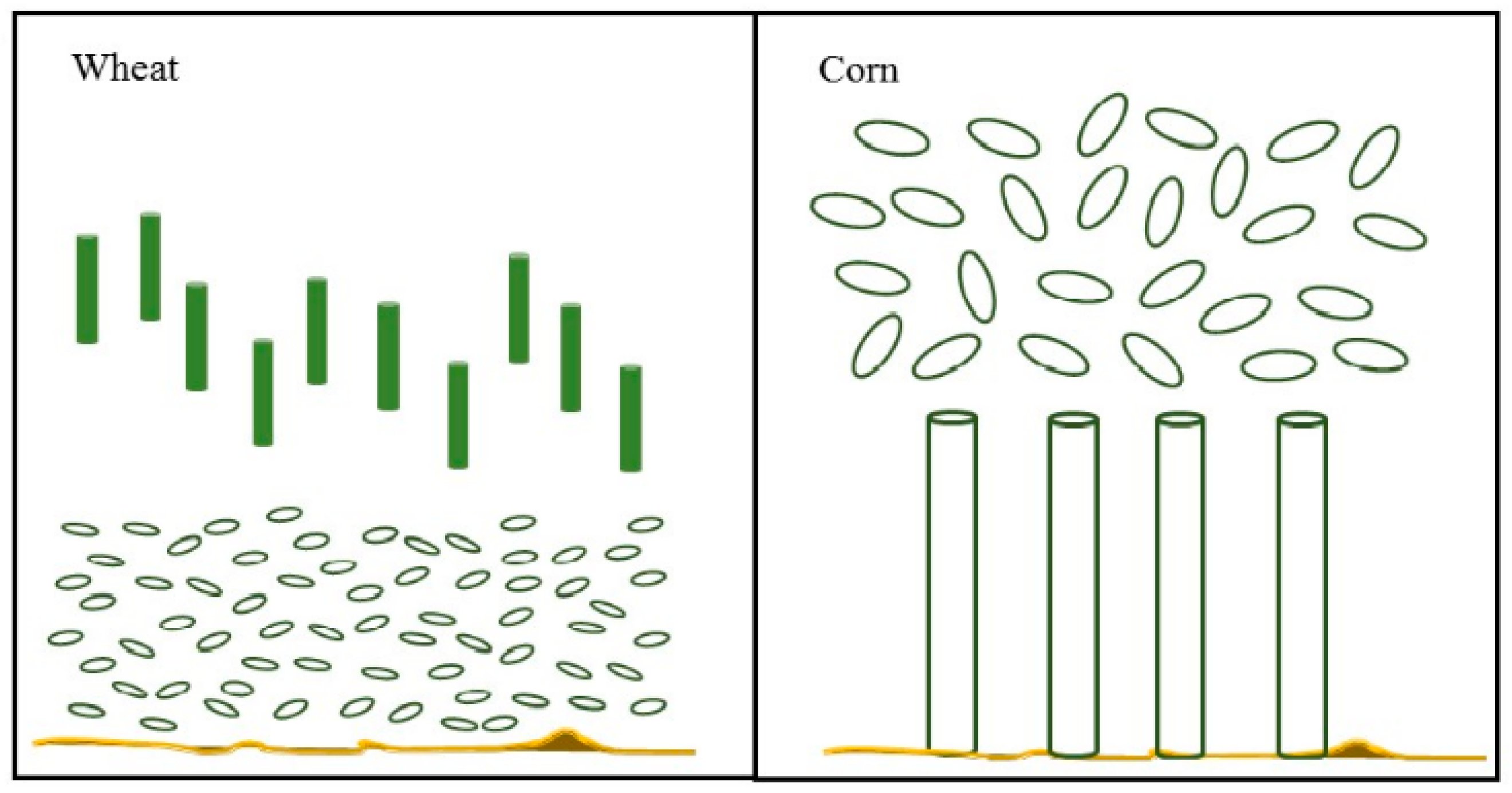

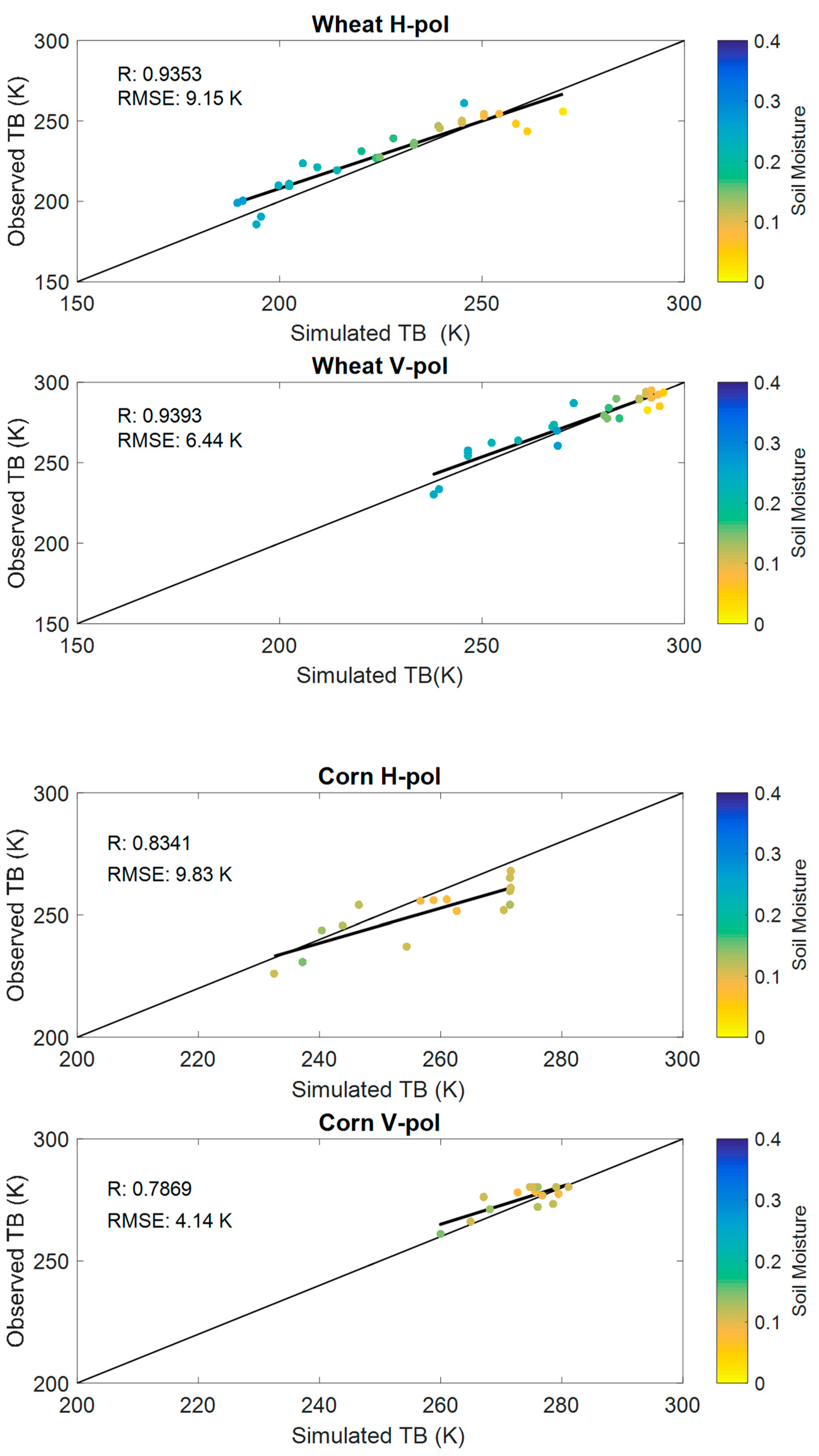
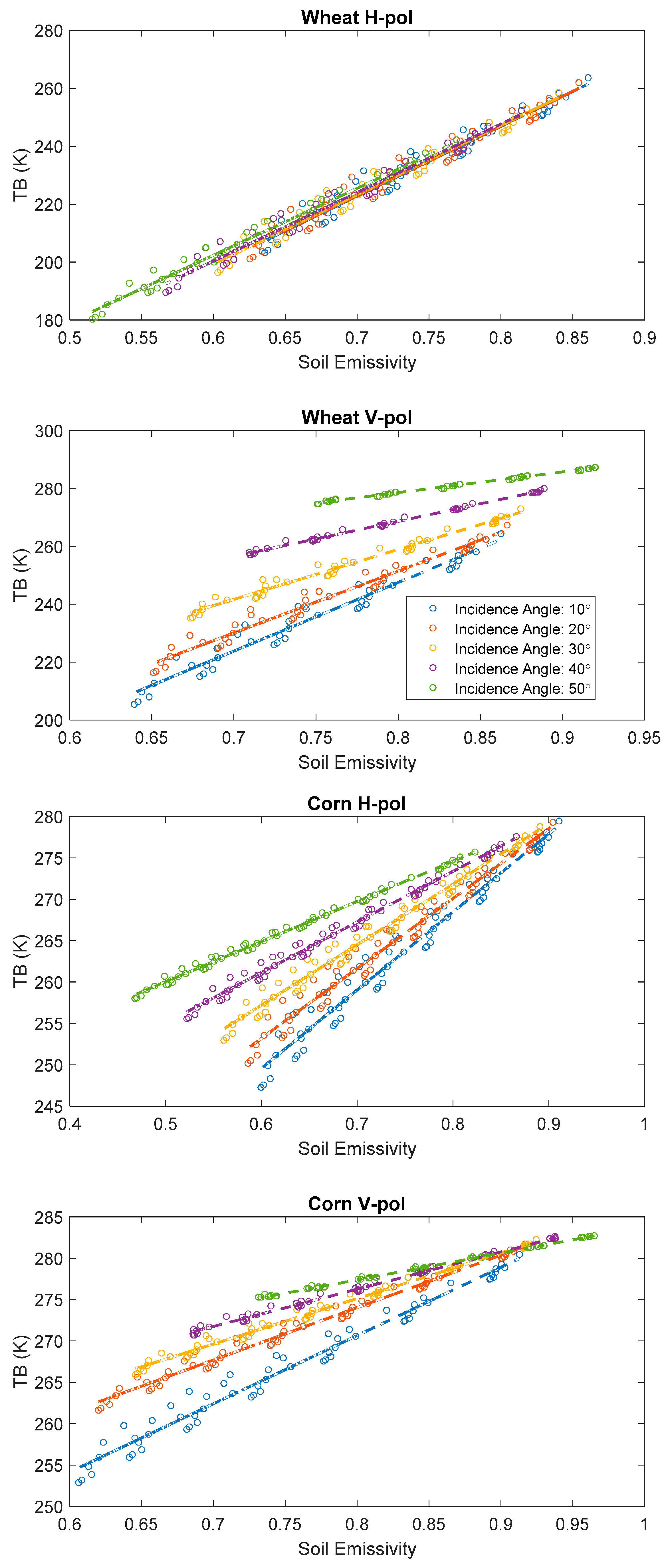
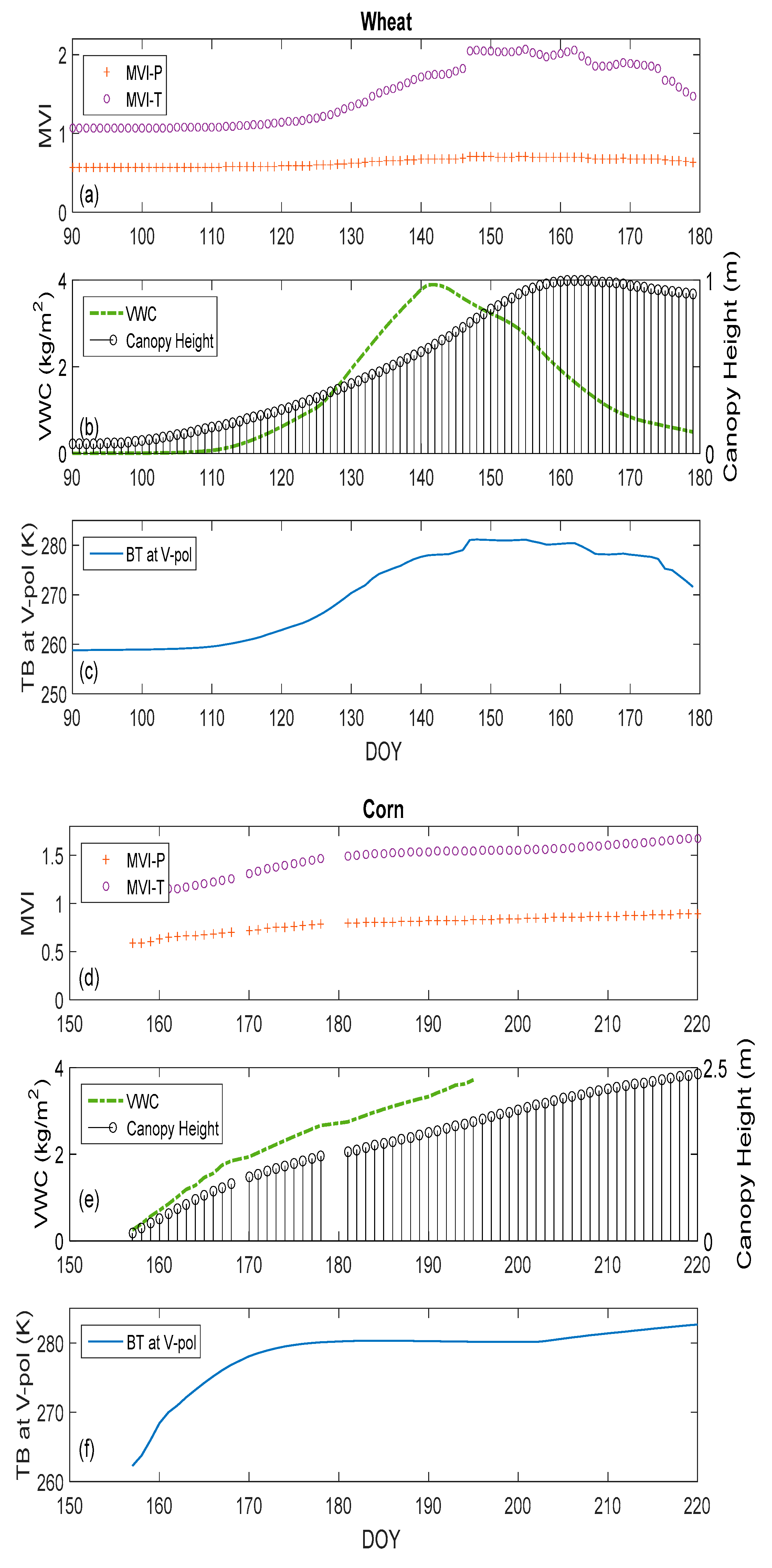
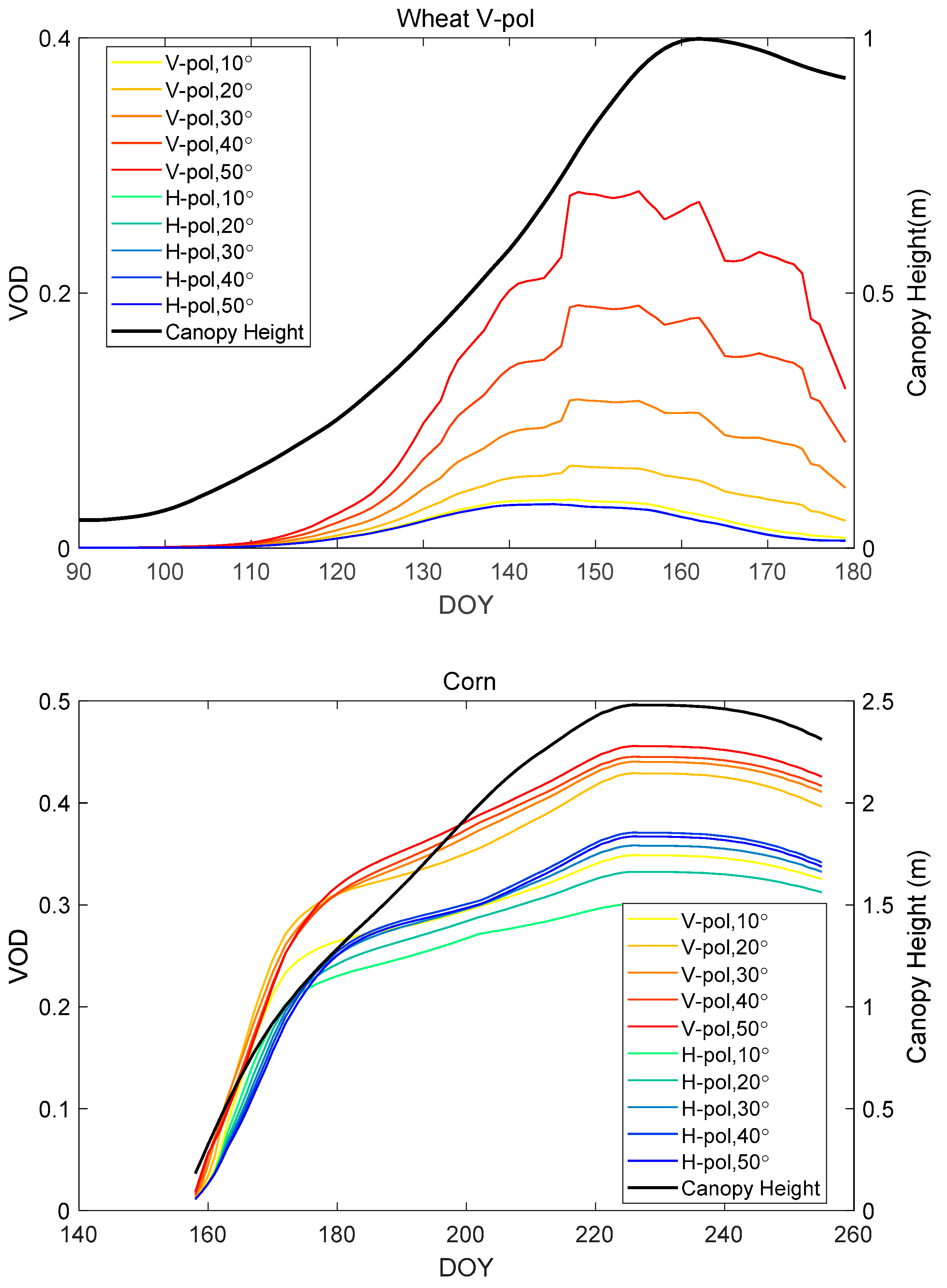
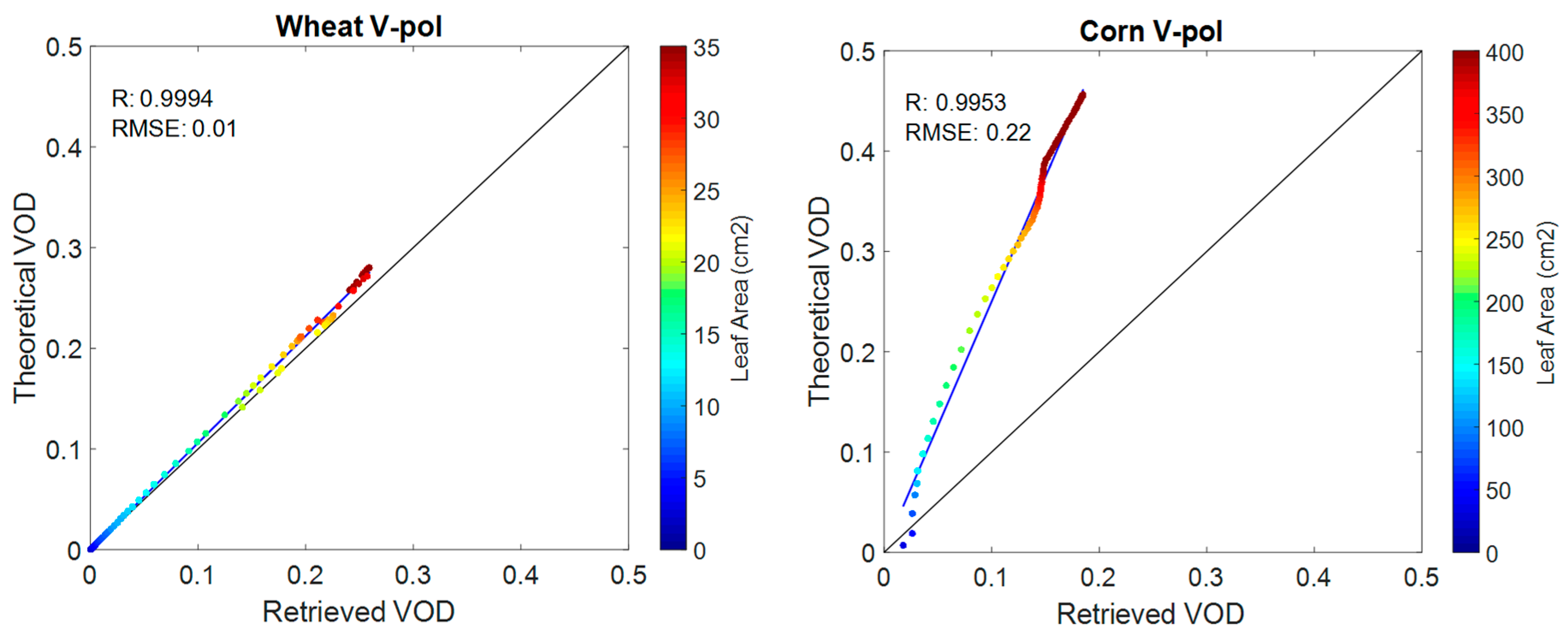
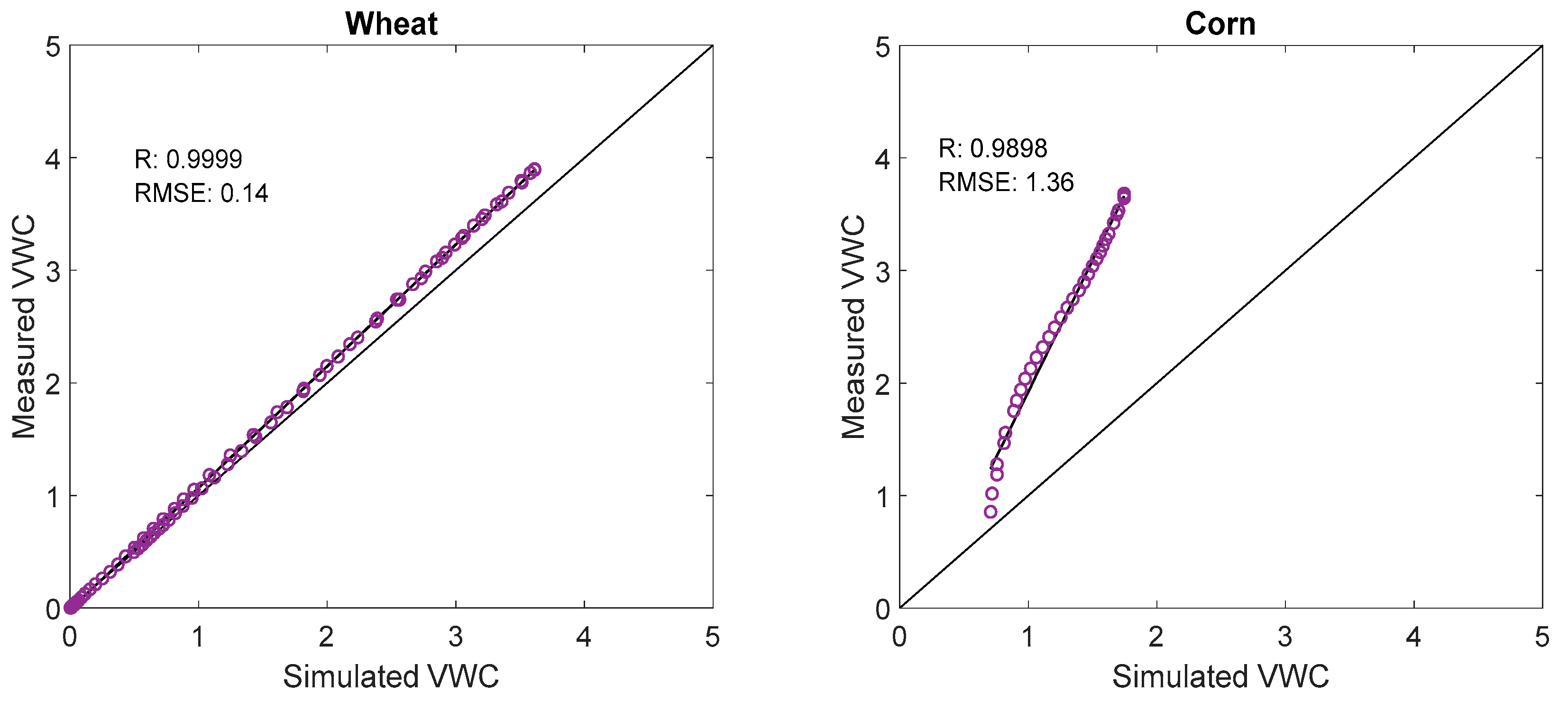
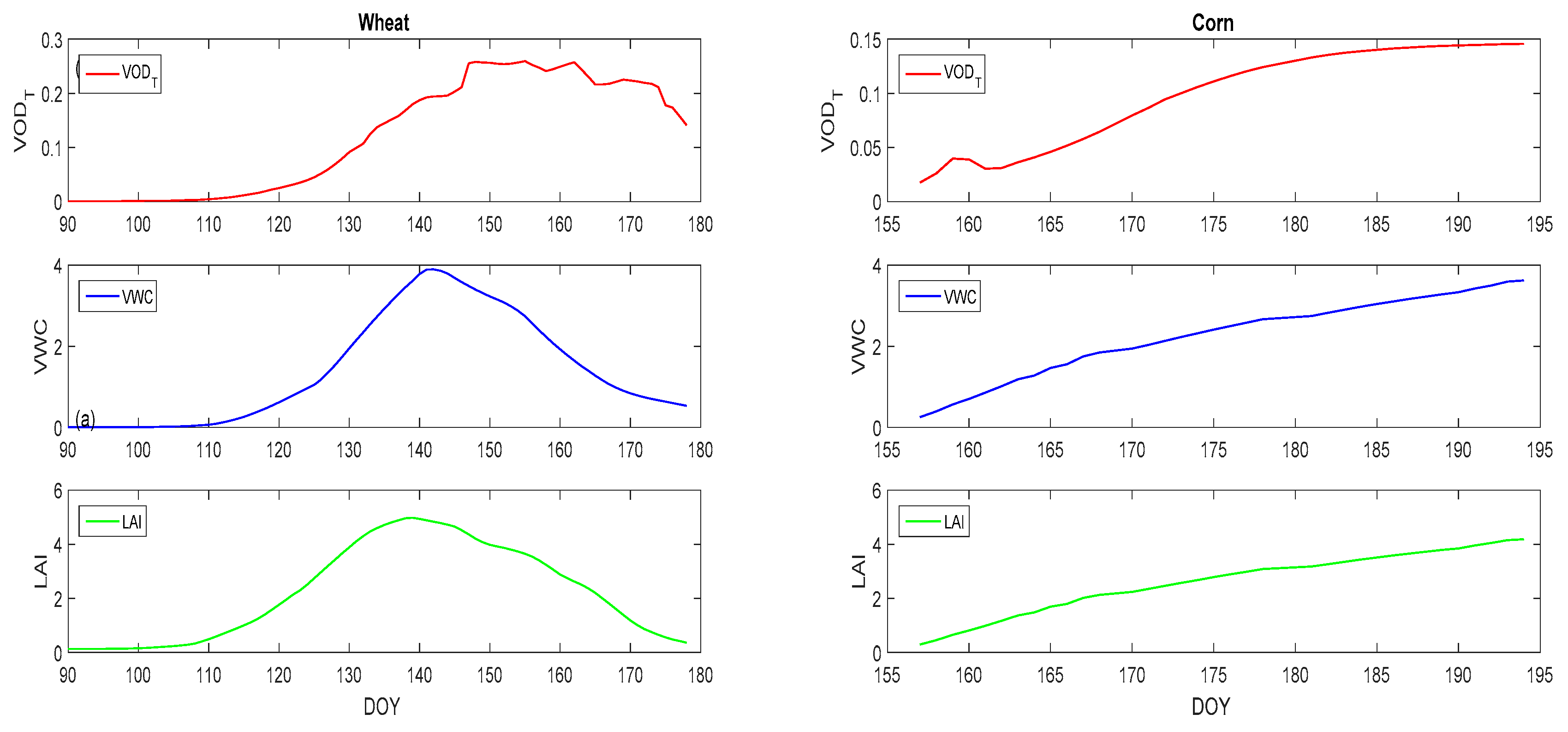
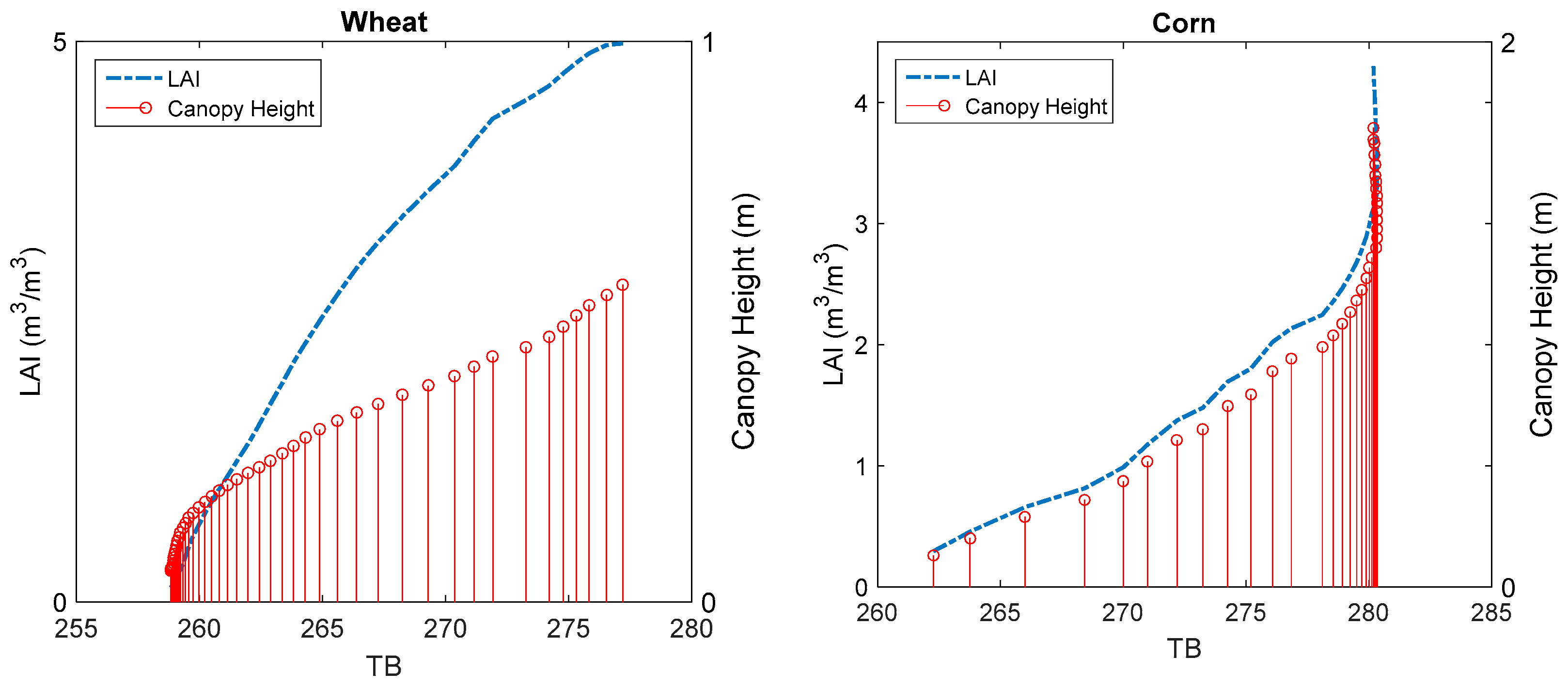
| Wheat Parameter | Unit | Min. | Max. | Corn Parameter | Unit | Min. | Max. | |
|---|---|---|---|---|---|---|---|---|
| Leaf | Radius | cm | 0.2 | 0.56 | Radius | cm | 1 | 4 |
| Thickness | mm | 0.017 | 0.02 | Thickness | mm | 0.2 | 0.4 | |
| Gravimetric Moisture | % | 0.66 | 0.81 | Gravimetric moisture | % | 0.70 | 0.90 | |
| Angle Distribution | degree | 5 | 85 | Angle distribution | degree | 5 | 85 | |
| Stalk | Radius | cm | 0.108 | 0.22 | Radius | cm | 0.2 | 1.2 |
| Length Gravimetric Moisture Angle Distribution | cm % degree | 3.57 0.66 0 | 76.3 0.84 0 | Length Gravimetric Moisture Angle distribution | cm % degree | 4 0.60 0 | 140 0.85 0 | |
| Layer | Mean Stalk Density Layer Height | m2 m | 80 0.16 | 600 99 | Leaf density Stalk density Layer height | m2 m2 m | 52 8 0.11 | 110 8 2 |
| Wheat | , V-pol | , H-pol | |
| MVI (10°, 20°) | 0.016 | 0.054 | 0.001 |
| MVI (20°, 30°) | 0.045 | 0.112 | 0.002 |
| MVI (30°, 40°) | 0.067 | 0.178 | 0.005 |
| MVI (40°, 50°) | 0.082 | 0.256 | 0.010 |
| Corn | , V-pol | , H-pol | |
| MVI (10°, 20°) | 0.060 | 0.101 | 0.072 |
| MVI (20°, 30°) | 0.070 | 0.072 | 0.070 |
| MVI (30°, 40°) | 0.090 | 0.095 | 0.078 |
| MVI (40°, 50°) | 0.104 | 0.162 | 0.085 |
© 2019 by the authors. Licensee MDPI, Basel, Switzerland. This article is an open access article distributed under the terms and conditions of the Creative Commons Attribution (CC BY) license (http://creativecommons.org/licenses/by/4.0/).
Share and Cite
Talebiesfandarani, S.; Zhao, T.; Shi, J.; Ferrazzoli, P.; Wigneron, J.-P.; Zamani, M.; Pani, P. Microwave Vegetation Index from Multi-Angular Observations and Its Application in Vegetation Properties Retrieval: Theoretical Modelling. Remote Sens. 2019, 11, 730. https://doi.org/10.3390/rs11060730
Talebiesfandarani S, Zhao T, Shi J, Ferrazzoli P, Wigneron J-P, Zamani M, Pani P. Microwave Vegetation Index from Multi-Angular Observations and Its Application in Vegetation Properties Retrieval: Theoretical Modelling. Remote Sensing. 2019; 11(6):730. https://doi.org/10.3390/rs11060730
Chicago/Turabian StyleTalebiesfandarani, Somayeh, Tianjie Zhao, Jiancheng Shi, Paolo Ferrazzoli, Jean-Pierre Wigneron, Mehdi Zamani, and Peejush Pani. 2019. "Microwave Vegetation Index from Multi-Angular Observations and Its Application in Vegetation Properties Retrieval: Theoretical Modelling" Remote Sensing 11, no. 6: 730. https://doi.org/10.3390/rs11060730
APA StyleTalebiesfandarani, S., Zhao, T., Shi, J., Ferrazzoli, P., Wigneron, J.-P., Zamani, M., & Pani, P. (2019). Microwave Vegetation Index from Multi-Angular Observations and Its Application in Vegetation Properties Retrieval: Theoretical Modelling. Remote Sensing, 11(6), 730. https://doi.org/10.3390/rs11060730








